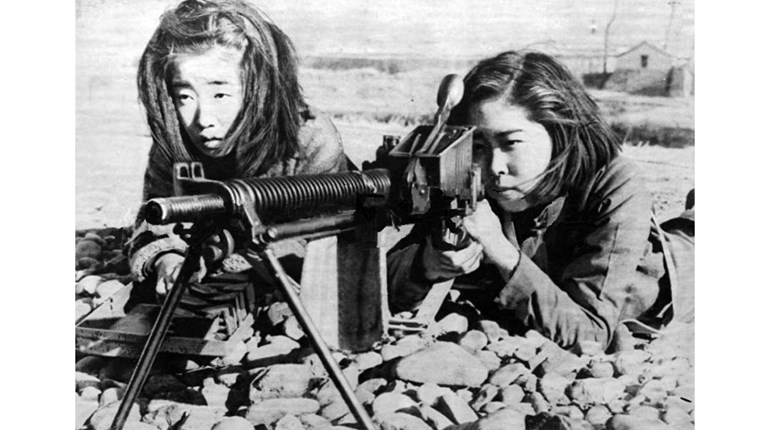
On June 9, 1944, a U.S. Navy LCVP picked up a group of 9th Air Force Troop Carrier Command pilots off Utah Beach in Normandy. At some point after midnight on June 6th, these men had steered Waco and Horsa gliders into landing zones in the hedgerows of the Cotentin Peninsula. After landing, they made their way down to the beach so they could be returned to their squadrons in England to fly future missions. Since they might encounter trouble between the landing zone and the beach, they carried individual weapons and ammunition. Some even took the extra precaution of camouflaging their helmets with strips of canvas scrim. When they climbed aboard, almost all of them lit a cigarette and one of them had to lean his souvenir firearms against the interior of the LCVP while he did so. Shortly thereafter, that landing craft pulled alongside a larger vessel, and those mementos were clearly visible when a photographer captured the moment on film. It is a familiar, well-known image from the D-Day invasion and it clearly reveals that one of the souvenirs is unquestionably an SVT-40. So, how did a Soviet rifle find its way to Normandy in time for June 6, 1944? The answer is quite simple actually: the German military standardized and issued thousands of captured examples of the SVT-40 under the designation SIGw.259(r) during the last three years of World War II.

That the Third Reich made extensive use of captured weapons throughout the Second World War is not exactly a revelation. Foreign-made rifles, pistols, machine guns and submachine guns armed German forces almost from the start and that has been well-known for decades. That the Wehrmacht took full advantage of the SVT-40 as soon as its fighting units began to capture examples of it on the battlefield during the latter half of 1941 especially makes sense. Although of Soviet origin, the SVT-40 offered something that Germany just did not have yet in 1941: a standardized, semi-automatic service rifle. Both Mauser and Walther were, by then, producing gas-operated self-loaders, but they were heavy, complicated and unpopular with the troops. Then came Operation Barbarossa’s inevitable haul of captured Russian guns, and there were SVT-40s in large numbers among the truckloads and truckloads sent back toward Berlin. As soon as the Germans got their hands on the SVT-40, they realized that its design provided numerous clear advantages to both the Mauser and Walther semi-autos in limited use at that time in the Wehrmacht under the designation G.41, so they began issuing it to the troops.

Like many other countries, the Soviet Union began the development of a semi-automatic service rifle long before the Second World War. Trials were held in 1928 and again in 1930 that produced a run-off between two prominent Russian designers: Sergei Gavrilovich Simonov and Fedor Vasilievich Tokarev. Although the Red Army ultimately adopted Simonov’s submission as the AVS-36 selective-fire rifle, in service a number of critical problems with the design quickly emerged. Because of this, production of the AVS-36 was terminated in 1938, and another semi-auto rifle trial was held to evaluate potential replacements. This time around, Fedor Tokarev submitted an improved rifle that was selected and adopted in a selective-fire version as the AVT-38 and in a semi-auto version as the SVT-38 (“AVT” standing for Avtomaticheskaya Vintovka Tokareva or “Tokarev automatic rifle” and “SVT” standing for Samozaryadnaya Vintovka Tokareva or “Tokarev self-loading rifle”). While the AVT/SVT-38 improved on the AVS-36, it still was not perfect. It was a little too heavy, its magazine release was prone to unintentional manipulation, and its cleaning rod mounted awkwardly on the right side of the stock rather than the more-traditional position directly beneath the barrel. A quick redesign that addressed those particular shortcomings produced the slightly modified although mechanically identical rifle that we know today as the SVT-40. It went into production at the Tula Arms Plant on July 1, 1940. Soon thereafter, Izhevsk Mechanical Plant began making it as well.

At a time when Springfield was still making “gas trap” M1 Garands and the Germans were still refusing to drill a gas port in the barrels of their semi-auto service rifles, the Soviets had a hammer-fired, semi-automatic rifle that used a short-stroke, gas-piston-operating system and fed from a 10-round, detachable-box magazine. With the SVT-40, the USSR had a rifle that gave its troops rugged reliability and, by virtue of the muscular 7.62x54 mm R cartridge, packed a formidable punch. In it, the Russians had a winner—and the Germans had it, too. Wehrmacht troops were notably fond of the SVT-40 in the years before the G.43 rifle was available to them. It was still around and fighting for the Third Reich during the summer of 1944 when allied forces kicked-in the door to Hitler’s Fortress Europe. That is how an American glider pilot came into possession of one on D-Day. Because of the photograph, we know he brought it aboard the landing craft that extracted him from Utah Beach. From there, he would have taken it back to England and, if he survived it all, maybe even back home after VE Day. We may never know what eventually happened to that SVT-40, but maybe it is sitting in an attic somewhere or maybe it is that rifle that you’ve been watching on Gunbroker recently.






































